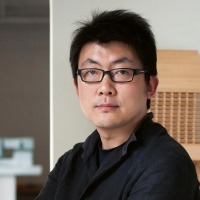The team of Vector Architects, with Gong Dong as principal architect, have designed this small library on the shore of the Bohai Sea. The design of the building began with the section, which evolves along the north-south axis, which gives different qualities to each space, establishing a unique relationship with the sea. The main spaces are the reading area, with stunning views of the sea, a meditation space and an activity room. Built in concrete, the library is full of details like the imprint of the shuttering on the concrete, the perforations on the roof of the reading room, or the orientation of the meditation sapace's windows, one to capture the morning light and the other to catch the sunset light.
Description of the project by Vector Architects
March 2014 A Site Visit
As the sky dims, cloud is dazzling in purple blue. Within a glimpse, it vanished. Ocean is in charcoal gray. The wave paddles to the sand with a rhythm that you can almost hear. It’s a resonate sound that travels deep and far. The sea breeze leaves its footprint onto the sand land, creating ripples of air waves. An old boat sits half-sunken under the sand, as if it has harbored here for years. There are few tarred down small houses used to be fishermen’s shelter. The leftover shingles and broken walls enclose space in dark. Through the dilapated openings on the wall, look out, is the sea in stillness, like paintings hanging upon the wall.
At that moment, we envision the future library should also be quietly sitting on the seashore. From outside, it looks like a weathered rock that is pure and solid; but inside, what it contains is the rich feelings and experiences. When walking into the space, one starts to feel the light, breezes, and sound of the ocean. What comes after the perception is the unique spiritual linkage between each individual and the sea. In here, everyone can slow down the usual pace, and unfold the feeling of distant and loneliness different from the city life.
The design began with section. The library houses a reading area, a meditation space, activity room, a drinking bar and a resting area. According to each space, we establish distinctive relationship between space and the ocean; define how light and wind enters into each room. If we slice through the building along the north-south long axis, we can see how each space elaborates itself with ocean distinctively. And the movement and memory of human body together choreograph series of experience.
During the construction phase, we worked with a local construction team and our biggest challenge was wood form poured-in-place concrete. The use of wood form was inspired by the sand marks of foot prints, wind and wheels on site. It implies a mark of memory in time that can be read as a poem. Wood grains are the marks of realization process that we want to leave on the library. Also, it softens the hardness of concrete with warmth.
Challenges came one after another. How do we keep those wood grains visible and even touchable? How do we create the concrete color we want? How do we avoid flaws such as leaking, cracking, and air bubbles? Those are crucial challenges we faced while working with construction team. We tested mock-ups of concrete wall three times to ensure the final quality. Each time, we made progress but also found new problems to be resolved. We continuously confront with much unknown and exploration throughout the entire procedure.
Text.- Vector Architects
CREDITS. DATA SHEET.-
Location.- Nandaihe, China.
Design Firm.- Vector Architects.
Principal Architect.- Gong Dong.
Project Architect.- Chen Liang.
Site Architect.- Yifan Zhang, Dongping Sun.
Design Team.- Zhiyong Liu, Hsi Chao Chen, Hsi Mei Hsieh.
Client.- Beijing Rocfly Investment (Group) CO., LTD.
Material.- Concrete, Laminated Bamboo Slate, Glass Block.
Structure.- Concrete Structure.
Area.- 450 m².
Dates.- Design: 02.2014- 07.2014; Construction: 07.2014- 04.2015.














































